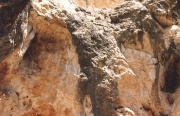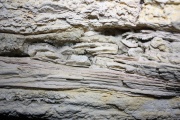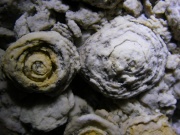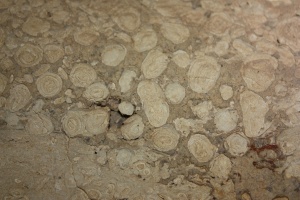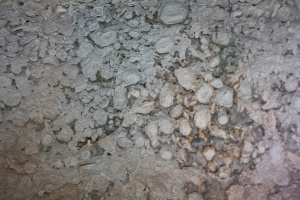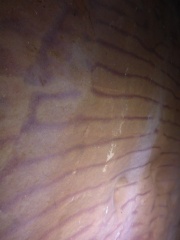Bedrock (Inventory)
From LagWiki
Contents |
Backreef
The Backreef field of the Bedrock section is used to list stations where backreef bedrock is observed.
Backreef is indicated by horizontal limestone and dolomite strata. The strata are usually thin and bedded with sandstone and dolomites. It is lightly colored and sometimes has large gastropods. Pisolites are a characteristic of backreef bedrock.
See also
References
- Various (June 2004) Core Values Carlsbad Caverns National Park; as published by Bob Hoff: http://carlsbadcavernshistory.blogspot.com/2011/05/carlsbad-caverns-national-park-core.html
- unknown (1997) Geology of Carlsbad Caverns Class - 1997 Memorial Day Expedition p 4
Massive
The Massive field of the Bedrock section is used to list stations where massive reef bedrock is observed.
The massive reef is indicated by unstratified limestone. It is poor in fossils (usually only algae and sponge). It is fine grained, light gray to cream colored and may contain many vugs.
See also
References
- Various (June 2004) Core Values Carlsbad Caverns National Park; as published by Bob Hoff: http://carlsbadcavernshistory.blogspot.com/2011/05/carlsbad-caverns-national-park-core.html
- unknown (1997) Geology of Carlsbad Caverns Class - 1997 Memorial Day Expedition p 4
Forereef
The Forereef field of the Bedrock section is used to list stations where forereef bedrock is observed.
Forereef is indicated by sloping, brecciated limestone strata. The color is light buff to pink. It often contains good fossils such as brachiopods, bryozoans, crinoids and sponges.
See also
References
- Various (June 2004) Core Values Carlsbad Caverns National Park; as published by Bob Hoff: http://carlsbadcavernshistory.blogspot.com/2011/05/carlsbad-caverns-national-park-core.html
- unknown (1997) Geology of Carlsbad Caverns Class - 1997 Memorial Day Expedition p 4
Breccia
The fields of the Breccia subsection of the Bedrock section are used to further classify breccia as to the binding agent in the matrix.
Breccia is composed of fragments of other rock cemented together by some kind of matrix. For purposes of the Carlsbad Cavern National Park Cave Inventory Form, the two possible matrices are calcite and silt.
Fields
Dike
Bedded Siltstone or Sandstone
The Bedded Siltstone or Sandstone field should be used to list stations that exhibit bedrock with siltstone or sandstone that is clearly bedded. Siltstone or Sandstone that appears as pods should be inventoried as Sand or Silt pods.
Bedded siltstone or sandstone may be found anywhere that bedrock is visible. It is an indicator of backreef.
See also
Pisolites
The Pisolites field should be used to list stations that exhibit bedrock with pisolites.
Pisolites are not a formation. They are an exposed characteristic of the original bedrock and exhibit as round nodules (sometimes with layers). They rarely appear singularly but instead most often appear in clusters or layers in the bedrock. The size can vary from pea-sized to larger. Very small varieties are often distinguished by being called "oolites" but for purposes of the CCNP Cave Inventory Form, all pisolites and oolites no matter their size should be inventoried in this field.
Pisolitic limestone (that is, bedrock limestone that contains pisolites) can be obscured by any type of secondary formation. They can also be found in breakdown -- anywhere that bedrock is exposed. They are a characteristic of backreef and are an indicator of backreef bedrock.
Pisolites are not to be confused with cave pearls.
See also
References
- Palmer, Arthur N. (2007) Cave Geology CAVE BOOKS, Dayton, OH p 67 ISBN-13: 978-0-939748-66-2, ISBN-10: 0-939748-66-5
Pisolites, Bedrock
Sand or Silt pods
Bedrock (Inventory)/Sand or Silt pods
Sandstone Ripple Marks
The Sandstone Ripple Marks field should be used to list stations that exhibit bedrock with sandstone that shows ripple marks. Siltstone or Sandstone that appears as pods should be inventoried as Sand or Silt pods and bedded sandstone should be inventoried as Bedded Siltstone or Sandstone.
Sandstone ripple marks may be found anywhere that bedrock is visible; but, it is usually found on the wall or in breakdown. It is an indicator of backreef.
See also
